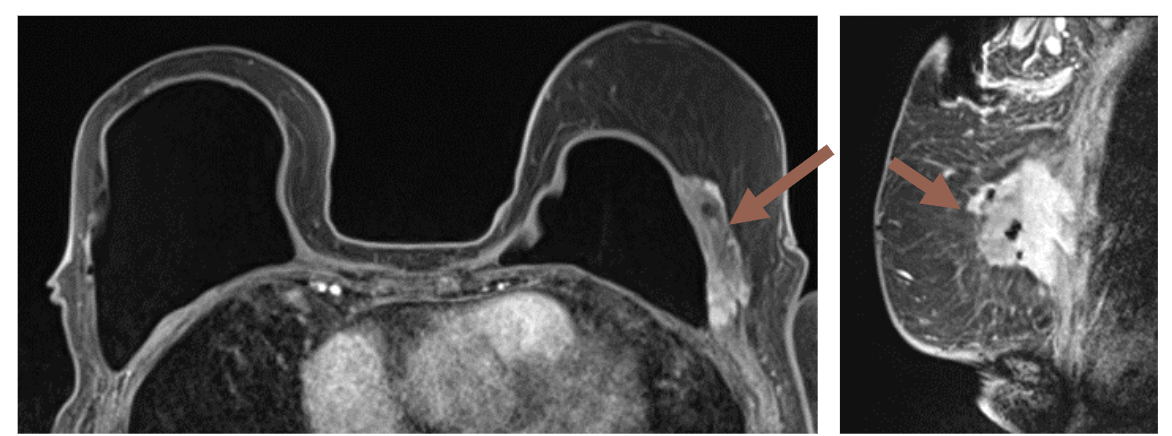Breast Reconstruction: Current Principles and Emerging Concepts in Imaging
Given the increasing prevalence of breast reconstruction, researchers discussed key signs of common complications on magnetic resonance imaging (MRI), ultrasound and other imaging during a recent presentation at the American Roentgen Ray Society (ARRS) 2023 Annual Meeting in Honolulu, Hawaii.
Offering a primer on common complications associated with primary breast reconstruction techniques as well as emerging alternative procedures, researchers at the American Roentgen Ray Society (ARRS) Annual Meeting discussed key considerations with complications found on post-op magnetic resonance imaging (MRI), ultrasound and other imaging.
While noting there are no current studies that support the use of surveillance imaging in women who have breast reconstruction procedures, researchers from the Mallinckrodt Institute of Radiology said knowledge of these techniques and potential complications is essential for breast radiologists.
“All radiologists that read breast imaging should be knowledgeable about normal and abnormal … complications/sequelae that might arise following breast reconstruction,” noted Risha Shah, M.D., M.P.H., a diagnostic radiology resident affiliated with the Mallinckrodt Institute of Radiology at the Washington University School of Medicine in St. Louis, Missouri.
Here are a few takeaways from the ARRS poster presentation by Shah and colleagues.
1. In regard to implant-based breast reconstruction, the poster authors noted that T1-weighted MRI scans of implants comprised of acellular dermal matrix reveal they are typically isointense to glandular parenchyma. They added that there is no enhancement with the use of gadolinium.
2. Seromas are commonly seen on early post-op ultrasound imaging as anechoic or complex fluid collections that resolve over time, according to the poster authors. They cautioned, however, that late presentation of seromas may be associated with anaplastic large cell lymphoma.
3. Computed tomography or MRI is usually necessary for differentiating between different types of autologous flap reconstruction. In contrast to implant-based breast reconstruction, radiologists will see a predominantly fatty appearance of the reconstructed breast in cases involving autologous flap reconstruction with other common normal findings including a vascular pedicle.
4. When mammography and ultrasound offer equivocal findings on the possible complication of fat necrosis, Shah and colleagues emphasized that MRI provides definitive evidence of benign findings and helps differentiate between acute and chronic fat necrosis. Acute fat necrosis can appear as irregular or round masses whereas chronic fat necrosis masses are round with smooth margins. Both kinds of fat necrosis masses have central high-signal intensity on non-fat-suppressed, unenhanced T1-weighted images and a high signal on T2-weighted images, according to the poster authors. They added that chronic fat necrosis masses display no enhancement on early or delayed images.
“The presence of central fat signal intensity is the key to differentiating fat necrosis from tumor recurrence,” noted Shah and colleagues.
5. The rare and locally aggressive fibroblastic desmoid tumor may mimic breast cancer on mammography exams with non-calcified, irregularly shaped masses with high density and spiculated margins, according to the poster authors. Usually exhibiting no potential for distant metastasis, desmoid tumors appear as hypoechoic, poorly marginated masses on ultrasound imaging with posterior attenuation and a thick echogenic rim. The study authors added that T1-weighted MRI images will show ill-defined hypo- to isointense masses whereas T2-weighted scans reveal heterogeneous hyperintense masses.
“(Desmoid tumors) show suspicious, slow enhancement after contrast administration,” pointed out Shah and colleagues. “(MRI) is also useful to show chest wall involvement.”
Images courtesy of the American Roentgen Ray Society.

6. The poster authors noted that post-mastectomy tumor recurrence may manifest as masses with intermediate signal intensity on T2-weighted MRI and low signal intensity on T1-weighted images. One may also note rapid enhancement after the use of gadolinium contrast. Malignancy risk is also increased with evidence of rim enhancement and spiculated margins, according to the poster authors.
7. While capsular contracture with breast implants is primarily a clinical diagnosis, Shah and colleagues noted that radiographic findings may include peri-implant calcifications and an increased number of radial folds. The poster authors said ultrasound offers the best imaging for thickening of the fibrous capsule that can occur with capsular contracture and added that linear hyperechoic areas superficial to the implant are another finding consistent with this diagnosis.
New AI-Enabled Portable Ultrasound May Facilitate 50 Percent Reduction in Cardiac Imaging Scan Time
March 28th 2025Artificial intelligence (AI)-powered measurement capabilities provide key features with the Compact Ultrasound 5500CV device, which will be unveiled at the American College of Cardiology (ACC) conference.
New Collaboration Offers Promise of Automating Prior Authorizations in Radiology with AI
March 26th 2025In addition to a variety of tools to promote radiology workflow efficiencies, the integration of the Gravity AI tools into the PowerServer RIS platform may reduce time-consuming prior authorizations to minutes for completion.
Can Photon-Counting CT be an Alternative to MRI for Assessing Liver Fat Fraction?
March 21st 2025Photon-counting CT fat fraction evaluation offered a maximum sensitivity of 81 percent for detecting steatosis and had a 91 percent ICC agreement with MRI proton density fat fraction assessment, according to new prospective research.